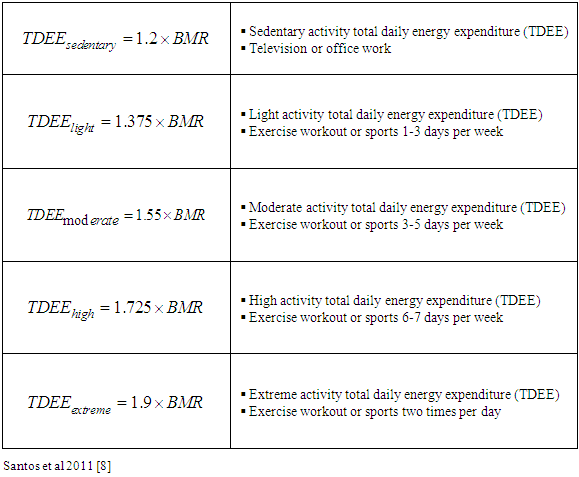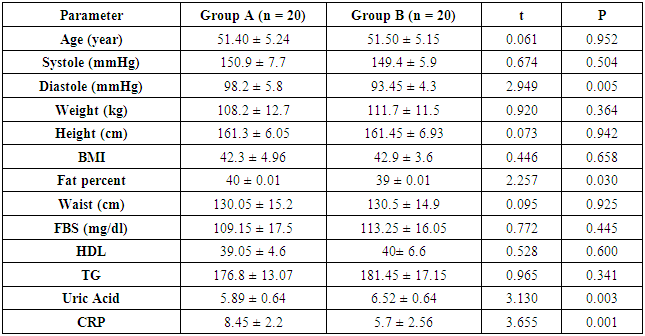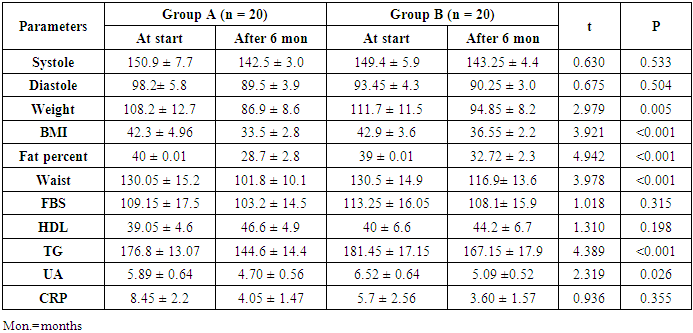-
Paper Information
- Next Paper
- Paper Submission
-
Journal Information
- About This Journal
- Editorial Board
- Current Issue
- Archive
- Author Guidelines
- Contact Us
International Journal of Internal Medicine
p-ISSN: 2326-1064 e-ISSN: 2326-1072
2017; 6(1): 10-15
doi:10.5923/j.ijim.20170601.02

Impact of Cryolipolysis and Weight Loss on Waist Circumference and the Components of the Metabolic Syndrome
Hamdi S. Nasser1, Osama Mohamad Ahmad2, Ahmed Salama Al Adl2
1Rheumatology, Physical Medicine and Rehabilitation Department, Faculty of Medicine, Al-Azhar University, Cairo, Egypt
2Internal Medicine Department, Faculty of Medicine, Al-Azhar University, Damietta, Egypt
Correspondence to: Ahmed Salama Al Adl, Internal Medicine Department, Faculty of Medicine, Al-Azhar University, Damietta, Egypt.
| Email: |  |
Copyright © 2017 Scientific & Academic Publishing. All Rights Reserved.
This work is licensed under the Creative Commons Attribution International License (CC BY).
http://creativecommons.org/licenses/by/4.0/

Background: Cryolipolysis is a method of non-invasive fat reduction that significantly reduces subcutaneous fat without injury to adjacent tissues and was approved by the Food and Drug Administration as a procedure to reduce subcutaneous fat. Aim of the work: To clarify the impact of cryolipolysis and weight loss on reduction of waist circumference and its impact on components of Metabolic syndrome. Patients and methods: This a prospective study was carried out on 40 post-menopausal female patients with metabolic syndrome selected from the outpatient clinic of Internal Medicine and Rheumatology clinic of Al Azhar University Hospitals. In the period from Dec 2015 to Aug 2016 all patients were divided in two groups according to the type of program introduced: Group A: 20 female patients underwent program of diet control and cryolipolysis sessions on the abdomen. Group B: (control group) 20 female patients underwent programe of diet control for 6 months. Patients and controls were submitted to full history taking; thorough clinical examination, waist circumference (WC), and BMI were calculated. Laboratory investigations included: lipid profile; fasting & post prandial blood sugar, serum uric acid at the start and after 6 months. Results: At the start of the study there was a statistically significant increase of diastolic blood pressure (98.20 ± 5.77) in Group A than Group B (93.45 ± 4.31). And there was statistically highly significant increase of CRP in Group A (8.45 ± 2.19) than Group B (5.70 ± 2.56). And there was a statistically significant increase of serum uric acid in Group B (6.52 ± 0.64) than Group A (5.89 ± 0.64). After 6 months from the start of the study there were statistically significant decrease of weight, BMI, fat percent, waist circumference, triglycerides, and serum uric acid in Group A than Group B. There were statistically highly significant decrease in systolic blood pressure, diastolic blood pressure, weight, BMI, waist circumference, fat percent, FBG, serum triglycerides, serum uric acid and CRP, in Group A after 6 months than at the start of the study. There was a statistically highly significant increase of HDL, in Group A after 6 months. There was a statistically highly significant decrease in systolic blood pressure, diastolic blood pressure, weight, BMI, fat percent, waist circumference, fasting blood glucose, triglycerides and serum uric acid, in Group B after 6 months than before. There was statistically non significant difference as regard to CRP before and after 6 months. Conclusion: Patients who underwent cryolipolysis and diet program had better improvement in components of metabolic syndrome than patients maintained over diet program alone. And measures to decrease waist circumference are associated with improvement of parameters of metabolic syndrome.
Keywords: Metabolic syndrome, Obesity, Waist circumference
Cite this paper: Hamdi S. Nasser, Osama Mohamad Ahmad, Ahmed Salama Al Adl, Impact of Cryolipolysis and Weight Loss on Waist Circumference and the Components of the Metabolic Syndrome, International Journal of Internal Medicine, Vol. 6 No. 1, 2017, pp. 10-15. doi: 10.5923/j.ijim.20170601.02.
Article Outline
1. Introduction
- Metabolic syndrome is a group of metabolic changes such as insulin resistance, hyperinsulinemia, abdominal obesity, impaired glucose tolerance, dyslipidemia, hypertension, and a proinflammatory and prothrombotic state Metabolic syndrome is considered as high risk for developing atherosclerotic vascular disease and type 2 diabetes [1].Cryolipolysis is a method of non-invasive fat reduction that significantly reduces subcutaneous fat without injury to adjacent tissues and was approved by the Food and Drug Administration as a procedure to reduce subcutaneous fat. Cryolipolysis causes apoptotic fat cell death and reduces subcutaneous fat thickness. The reduction of subcutaneous fat in the flanks, upper and lower limbs, and abdomen can be achieved [2]. Precise application of cold temperatures induce death of adipocytes that are subsequently engulfed and digested by macrophages [3]. No changes in subcutaneous fat are noticeable immediately after treatment. An inflammatory process stimulated by apoptosis of adipocytes, as reflected by an influx of inflammatory cells, can be seen within 3 days after treatment and peaks at approximately 14 days thereafter as the adipocytes become surrounded by histiocytes, neutrophils, lymphocytes, and other mononuclear cells. At 14–30 days after treatment, macrophages and other phagocytes surround, envelope, and digest the lipid cells as part of the body’s natural response to injury. Four weeks after treatment, the inflammation is decreasing and the adipocyte volume is decreased. Two to 3 months after treatment, the interlobular septa are distinctly thickened and the inflammatory process further decreases. By this time, the fat volume in the treated area is apparently decreased [4].The applicator of the cryolipolysis machine is applied to the selected area to be treated contains two opposing cooling panels that’s apply cold energy which affects only the adipocytes [5].Expected side effects are temporary erythema, bruising, and transient numbness that usually resolves within 14 days after treatment. With more than 850,000 procedures performed worldwide, only 850 adverse events have been reported. The most common complaint is late-onset pain, occurring 2 weeks post-procedure that resolves without intervention [6].
2. Aim of the Work
- The aim of this study was to clarify the impact of cryolipolysis and weight loss on reduction of waist circumference and its biological impact on components of Metabolic syndrome.
3. Patients and Methods
3.1. Study Designs
- This a prospective study was carried out on 40 female patients with metabolic syndrome selected from the outpatient clinic of Internal Medicine and Rheumatology clinic of Al Azhar University Hospitals in the period from Dec 2015 to Aug 2016 all patients were divided in two groups according to the type of program introduced: Group A: 20 female patients underwent program of diet control and cryolipolysis sessions on the abdomen. Group B: (control group) 20 female patients underwent programmed diet control for 6 months.
3.2. Ethical Aspects
- The research protocol did not interfere with any medical recommendations or prescriptions, all interference was explained in details to all participants and informed consent was obtained from all patients.
3.3. Inclusion Criteria
- Post menopausal Obese female patients with criteria of metabolic syndrome. Metabolic syndrome was defined according to the following criteria: abdominal obesity (defined by waist circumference > 88 cm in female), in addition to two or more of the following: (Hypertriglyceridemia >150mg/dl and low HDL-c: <50 mg/dL; high blood pressure; systolic blood pressure >130 or diastolic blood pressure >85mmHg; fasting blood glucose >100 mg/dl or previously diagnosed as type 2 diabetes [7].
3.4. Exclusion Criteria
- Obese patients without criteria of metabolic syndrome, pre menopusal obese female patients, Presence of any concomitant systemic illness, chronic kidney disease, Thyroid disease, Metabolic Bone Disease, Hepatic disease, presence of acute illness and recent trauma and steroid intake.
3.5. Study Protocol
- All included patients underwent the following: Full History taking & clinical examination, Blood pressure measurements, Waist Circumference were measured in cm, Weight (kg) and Height (m) was recorded, Body mass index (BMI) = weight (kg)/ height2 (m2), Underweight = <18.5, Normal weight = 18.5–24.9, Overweight = 25–29.9, Obesity = BMI of 30 or greater, (7). Laboratory investigation: General investigations to exclude the presence of any comorbidities: CBC, ESR, serum Creatinine, SGPT, SGOT, Thyroid Stimulating Hormone, serum uric acid, C-reactive protein. Specific investigations for metabolic syndrome: Blood glucose level, fasting and 2 hours postprandial, complete lipid profile, Body fat analysis was done to both groups and Cryolipolysis was done to group A as the following: § Cryolipolysis:We use two cryo Handles fat freezing machine, hand piece with vacuum, we divided the abdominal area into four parts by vertical and horizontal umbilical lines: right and left upper umbilical areas, right and left lower umbilical areas. Each area received 60 minutes cryolipolysis session every 45 days for 6 months (4 session for each area in 6 months). The suction pressure was 60 kpa (kilo pascal) and the temperature was -5°C. Separator sheet was put on the skin to prevent skin complication of freezing (burn, bruising and echemosis. The patient lies in a supine position with 30- 45 degree for dorsal and head. After finishing the cryolipolysis session 2 minutes massage was done to decrease the pain and decrease echemosis.§ Body fat analysis:Body fat analysis was done by Body fat analyser (Beurer BF 100_Body Complete, Germany) which use both hands and feet electrodes by step Bare foot onto the scale and hold the controle unite firmly with lower part of the thumb pressed firmly on front electrode and finger pressed firmly on the near electrode, the weight and impedance was measured and analysis to the following: weight, body fat percent, upper body fat, lower body fat, water percente, muscle percent, bone mass(kg) Basal Metabolic Rate (kcal (kilo kalories)), Activity Metabolic Rate (kcal).§ The Nutrition program includes: Diet control was done according to weight loss equation formulas calculated to determine Basal Metabolic Rate (BMR) for each patient. Weight Loss Equations Formulas Calculator Solving for Female Basal Metabolic Rate (BMR): BMR (female) = 655+ (9.6×weight) + (1.8×height) – (4.7×age). No difference between both studied groups as regard to caloric diet, we gradually decrease 20% - 30% of TDEE needed for all patients by caloric diet control according to patient condition. As regards to lifestyle our patients are house wife or office workers with no exercise activity. Total Daily Energy Expenditure (TDEE) is calculated from the table of Activity Multiplier as the following:
|
3.6. Statistical Methodology
- The data were processed and analyzed using the statistical package for social sciences (SPSS) 17.0 program. Quantitative variables were presented in the form of Mean and Stander Deviation (mean±SD), while Qualitative variables presented by relative frequency and percentage. Chi-square test was used to compare qualitative variables between groups. Unpaired t-test was used to compare quantitative variables, in parametric data. Significance level (P) value was expressed as follows: P >0.05 (Insignificant); P<0.05 (Significant); and P<0.01 (High significant). Percent of changes was calculated as follow (Numerical value at the start of the study - Numerical value after 6 months of the study divided on value at the start of the study × 100).
4. Results
- At the start of the study there was a statistically significant increase of diastolic blood pressure (98.20 ± 5.77) in Group A than Group B (93.45 ± 4.31). And there was statistically highly significant increase of CRP in Group A (8.45 ± 2.19) than Group B (5.70 ± 2.56). And there was a statistically significant increase of serum uric acid in Group B (6.52 ± 0.64) than Group A (6.52 ± 0.64). (Table 2).
|
|
|
|
5. Discussions
- Central adiposity is a component of the metabolic syndrome (MetS). Our objective was to show the impact of cryolipolysis and weight loss on waist Circumference and the components of the Metabolic syndrome like changes on blood pressure, lipids and glycemic control.Cryolipolysis is a promising procedure for nonsurgical fat reduction and body contouring and presents a compelling alternative to liposuction and other, more invasive methods. This procedure appears to be safe in the short term, with a limited side effect profile, and results in a significant fat reduction when used for localized adiposities. It remains unclear whether post treatment manual massage and multiple treatments in the same anatomic area enhance the efficacy of cryolipolysis [9].In our study after 6 months from the start of the study there were statistically significant decrease of weight, BMI, fat percent, waist circumference, triglycerides, and serum uric acid in Group A than Group B. Indicating the beneficial effect of diet program and cryolipolysis than a diet program alone for improving the parameters of metabolic syndrome in addition to the reduction of waist circumference is associated with improvement of parameter of metabolic syndrome. Mahmoud eldesoky et al., (2015) [10] reported that cryolipolysis is safe and effective for the reduction of abdominal fat thickness and for abdominal contouring. Our results disagree with three studies evaluated lipid levels and liver function tests after cryolipolysis treatment [13-15] and showed no significant impact was noted on lipid levels or liver function tests in any study this may explained by the usage of cryolipolysis program alone in this studies but we use combinations of diet program in addition to cryolipolysis in our study. Central adiposity is a component of the metabolic syndrome (MetS). Little is known about the impact of medical weight loss and decreased waist circumference (WC) on the MetS. [11]Samuel et al 2014 [16] reported that weight loss program may contribute to changes in body composition and markers of metabolic syndrome in obese subjects. In the present study in Group B there was a statistically highly significant decrease in systolic blood pressure, diastolic blood pressure, weight, BMI, fat percent, waist circumference, fasting blood glucose, triglycerides and serum uric acid, after 6 months than the start of the study. This agrees with Case et al., 2002 [11] who reported that Moderate weight loss markedly improved all aspects of the MS also agree with Hye et al., 2004 [15] who reported that a moderate weight reduction was associated with substantial reduction in metabolic risk factors of metabolic syndrome or insulin resistance in obese patients that appeared to be partially mediated by the corresponding reductions in abdominal fat distribution. The benefit of weight reduction was found to be greater among individuals with the metabolic syndrome than in those without the metabolic syndrome.
6. Conclusions
- Patients who underwent cryolipolysis and diet program had better improvement in components of metabolic syndrome than patients maintained over diet program alone. And measures to decrease waist circumference are associated with improvement of parameters of metabolic syndrome.
Abbreviations

 Abstract
Abstract Reference
Reference Full-Text PDF
Full-Text PDF Full-text HTML
Full-text HTML



